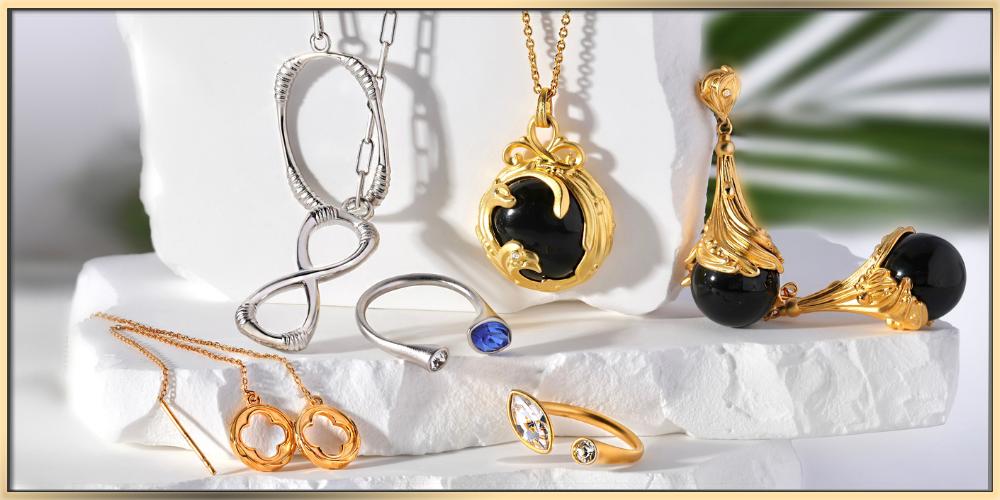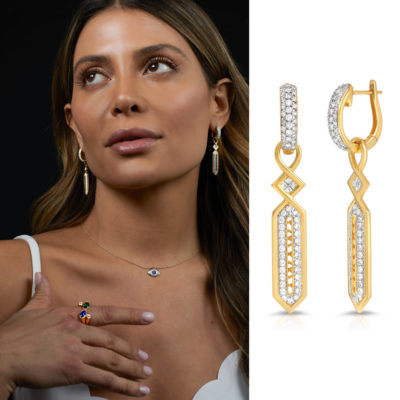Tips & Recommendations
What Metals Are Least Likely To Cause An Allergic Reaction?
Living with a sensitivity to metal isn’t always easy. Coins, eyeglasses, jewelry, and many other common items can cause irritation. Some people just get a little bit of redness, but for others it can mean swelling and pain. Luckily, this allergy is quite common, and this means that many jewelers and stores, like ARY D’PO make sure they have a range of hypoallergenic jewelry in stock for their customers. But what does “hypoallergenic” really mean, anyway? And what metals are least likely to cause an allergic reaction? Well, in this post we have all the answers, so you can make sure you’re buying jewelry that won’t cause you any rashes, itchiness, or unnecessary stress.
Why do some metals cause allergic reactions?
Allergies are an immune system disorder that affect a huge number of people. Scientists don’t really know why allergies exist, but many think that it’s just a result of your immune system being overly cautious about the things you come into contact with. Essentially, your body treats an allergen as a foreign invader, and the symptoms are your body’s way of warning you to get away from whatever’s causing it.
From nuts to shellfish to laundry powder, there are many common things that lots of people have reactions to. Metals are one of them. If you’re allergic to metal, some of the effects you might experience when you come into contact with metals include:
- Skin rashes or bumps on your skin.
- Itchiness.
- Redness.
- Dry skin.
- Swelling.
- Pain.
These symptoms can range from mild to severe, but they’ll usually be the same every time you come into contact with a certain metal. Some people are only sensitive to one kind of metal (nickel is a common one), and others have reactions to many types.
If you have a metal allergy, you may need to be careful about the jewelry you buy. Luckily, many types of jewelry are hypoallergenic – which means they tend to be non-reactive. But what does that really mean? And which metals are least likely to cause an allergic reaction?
What is hypoallergenic jewelry?
When you’re shopping for new necklaces, bracelets, or earrings, you might see some brands marketing their jewelry as “hypoallergenic”. While this usually means that it’s unlikely to irritate your skin, it’s important to note that this isn’t a scientific term. There aren’t any official standards about what metals hypoallergenic jewelry will or won’t contain.
A lot of the time, hypoallergenic jewelry is simply that which is nickel free. It may contain many other metals, but “hypoallergenic” often means “nickel free” because nickel is the usual culprit for metal allergies. If you’re allergic to a less common metal, this is definitely something to keep in mind. For instance, if you get a reaction from zinc or copper, check that the jewelry doesn’t contain these other common alloys.
Hypoallergenic jewelry can also refer to certain types of metals which only very rarely cause allergic reactions. While it’s possible to be allergic to any type of metal, some (such as platinum, gold, and rhodium) are almost always okay. Because of this, these pure metals are often labeled as hypoallergenic.
Metals least likely to cause an allergic reaction
As we’ve discussed, some metals (such as nickel) are fairly likely to cause an allergic reaction. Others (such as platinum) only very rarely cause irritation. So, which are the safest metals?
Gold
Gold is a beautiful, timeless metal that many people love. However, because it’s too soft to make into jewelry on its own, it almost always contains other metals to strengthen it. Some of these metals may cause irritation. Look for gold jewelry that’s 18 karats or higher and be sure to check what other metals have been used to make it.
It’s also worth thinking about the fact that rose gold, yellow gold, and white gold are all mixed with different metals to give each a unique hue. Rose gold usually contains copper, whereas white gold often has a lot of nickel in it. So, if white gold causes a reaction, you don’t necessarily need to quit gold entirely. Instead, you might just need to find the alloy that works for you.
Sterling silver
Sterling silver is a very popular jewelry material. Because of its gorgeous color, high quality, and affordability, it’s no wonder so many people love it. Because silver is so soft on its own, sterling silver is that which has been mixed with another metal to make it a little harder and more durable. Usually, the mix is 92.5% silver to 7.5% other metals.
The most common sterling silver contains copper along with silver. While some people are allergic to copper, it’s definitely a less common allergy than nickel. This means that most people who are sensitive to metal will find sterling silver to be fine. However, just be aware that there’s no guarantee that your sterling silver won’t contain nickel, so it’s a good idea to check before you buy.
Plated jewelry
Some jewelry is made of a base metal, and plated with a thin layer of gold, rhodium, or another metal. This can be a great way to avoid an allergic reaction, especially when you’re on a budget. You can get the stunning look and hypoallergenic qualities of stronger metals, while only paying for a thin layer of it.
Just make sure you check what metal is underneath the plating. It might be fine for years, but you don’t want to experience any irritation when the plating eventually begins to wear away.
Stainless steel
Many people choose stainless steel jewelry as a great hypoallergenic option. This metal is often used in medical settings, and is highly resistant to rust and corrosion. It’s also quite affordable.
However, you need to be careful to get the right grade of stainless steel. There’s more than 100 grades. Some contain nickel and others don’t. For instance, 430 grade is low in nickel. Make sure you avoid 304 stainless steel, which is often more than 10% nickel. Before buying stainless steel jewelry, always look it up and check what metals it contains.
Titanium
This metal is extremely strong and durable. It’s well known for being a lightweight and comfortable metal to wear. This is why it’s so common in medical implants. It’s also often used for wedding bands and other types of permanent jewelry, such as belly button rings. It’s not too pricey either, so it has a lot going for it!
Some people with metal sensitivities actually buy multipacks of titanium earring hooks online. You can grab a pair of pliers and replace the hooks on any earrings with your hypoallergenic titanium hooks. This way, you can enjoy the cute charms from any earrings you like, without worrying about having a reaction. This won’t be safe for people with severe allergies, but if you’re just prone to mild irritation, this can be a great option.
Platinum and rhodium
The metals in the platinum family are some of the rarest and most valuable jewelry materials. They’re very hard, durable, and stunning. Many people say that, out of all the metals on the market, these metals are the least likely to cause an allergic reaction.
Platinum is often used in its pure form, whereas rhodium is too brittle to turn into jewelry. Most rhodium jewelry is made of another material which is then plated with rhodium. Even though the rhodium plating will usually stay intact for a couple of years, it will eventually wear off. Therefore, it’s always wise to make sure you’re not allergic to the base metals.
Final tips for buying jewelry that won’t cause an allergic reaction
There are several things you can do to make sure you’re buying jewelry that will feel comfortable for you. It’s always a good idea to:
- Figure out exactly which metals you’re allergic to. If you have been experiencing allergic reactions from jewelry, it can be a good idea to ask your doctor to perform a patch test. This way, they can test your skin and work out if nickel’s the problem, or if it’s something else. When you have the results of your tests, you can feel confident you’re buying the right jewelry for you.
- Talk to your jeweler – and always read the fine print. If you’re buying jewelry labeled hypoallergenic, make sure you find out exactly what that means before paying for it. Is it nickel free? What else does it contain? Read descriptions and be sure to ask the seller if you have questions.
- Avoid costume jewelry. Cheap and trendy jewelry usually contains nickel, and sometimes this isn’t clearly stated. It’s often safest to avoid costume jewelry altogether.
- Remember that different types of jewelry can have different effects. If you have a mild metal allergy, you might be fine with necklaces and bracelets, but not earrings. Since earrings go right through your skin, they can often cause more irritation than other types of jewelry. Be sure to be extra careful to check the materials used when buying new earrings.
If you suspect you’re sensitive to metal, don’t worry! There are many gorgeous hypoallergenic options on the market. We hope this post will help you find the right pieces that keep you feeling comfortable – as well as stylish.


